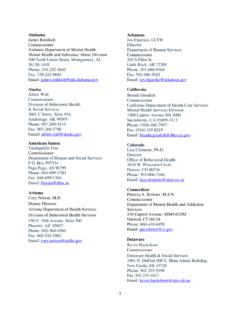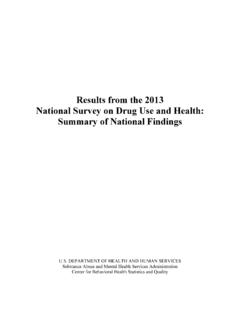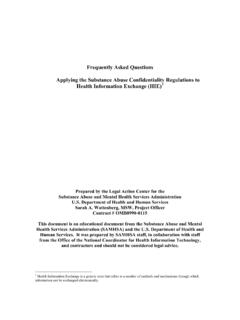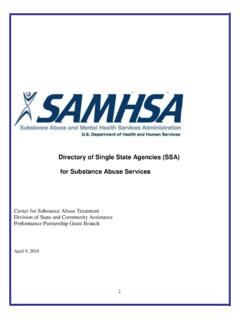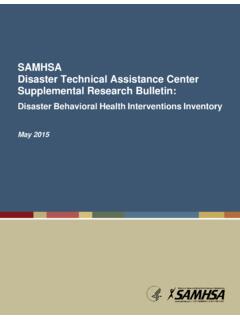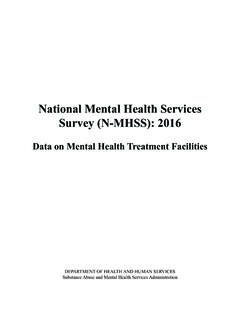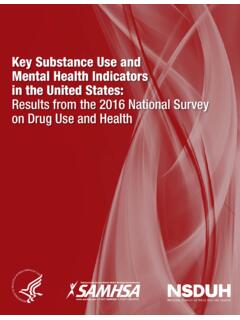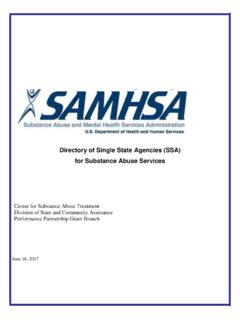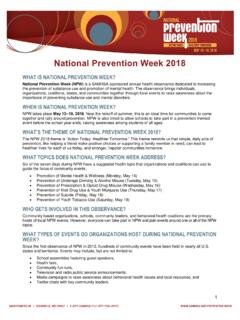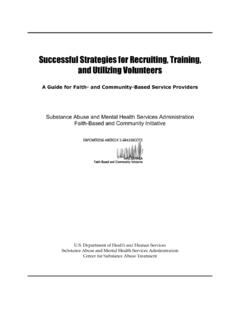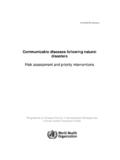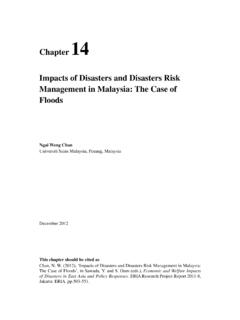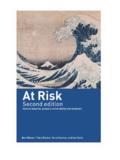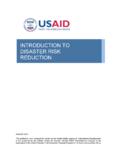Transcription of Behavioral Health Conditions in Children and Youth Exposed ...
1 SAMHSAD isaster Technical Assistance Center Supplemental Research BulletinBehavioral Health Conditions in Children and Youth Exposed to natural DisastersSeptember 2018 CONTENTSINTRODUCTION 3 Common Stress Reactions in Children and Youth After a disaster 5 BACKGROUND 6 Behavioral Health Conditions in Exposed Youth 6 Stress and Posttraumatic Stress Disorder/Symptoms 6 Depression 7 Substance Use 8 Anxiety Disorders 8 Other Mental Disorders 8 Physical Consequences 8 Comorbidities 8 RISK AND PROTECTIVE FACTORS FOR MENTAL AND Behavioral Health IN Youth 9 Non-modifiable Risk and Protective Factors 9 Modifiable Risk and Protective Factors 10 Impact of Indirect Exposure to natural disaster 10 Children s Reactions to News About Disasters by Age Group 10 INTERVENTIONS TO IMPROVE POST- disaster Behavioral Health IN Children AND Youth 11 General Intervention Strategy 11 Screening 11 Important Considerations 12 Guidance in Selecting Interventions 13 Methodologies for Supporting Children After natural Disasters 13 Select Post- disaster Interventions for Children 13 CONCLUSION 15 REFERENCES 16 The focus of the Supplemental Research Bulletin is to provide an overview of the current literature on a specific topic and make it easy to understand for disaster Behavioral Health professionals who are not otherwise Exposed to the research.
2 The product aims to assist professionals and paraprofessionals involved in all-hazards planning, disaster Behavioral Health response and recovery, and/or Crisis Counseling Assistance and Training Program grant activities.| Page 3 INTRODUCTIONThis issue of the Supplemental Research Bulletin focuses on mental Health and substance use ( Behavioral Health ) Conditions in Children and adolescents following exposure to natural disasters such as hurricanes, tornadoes, and year, natural disasters affect an average of 224 million individuals worldwide, and about million in North America. In the United States, the average number of natural disasters per year over the past decade was , making the United States one of the top five countries in the world in terms of how frequently it was hit by natural disasters (Guha-Sapir, Hoyois, Wallemacq, & Below, 2017). Winter storm Jonas alone (2016) affected about 85 million people (Guha-Sapir et al.)
3 , 2017). Children under the age of 18 comprise nearly 25 percent of the United States population, or 74 million Americans (National Commission on Children and Disasters, 2010). In a representative sample of Children ages 2 to 17 years, percent had been Exposed to a disaster in their lifetime, while percent of the sample reported experiencing a disaster in the past year (Becker-Blease, Turner, & Finkelhor, 2010). As these statistics reflect, many Children are Exposed to disasters, and they constitute a population with particular risks and needs during and after disasters (Becker-Blease, Turner, & Finkelhor, 2010; National Commission on Children and Disasters, 2010).Researchers have found mental Health problems and Conditions including depression, anxiety, and general distress in disaster survivors of all ages (Norris et al., 2002). Children differ from adults physically, developmentally, and socially, which results in a need for disaster response services designed specifically for Children of particular age groups.
4 Disasters pose a higher risk for Children because of young Children s inability to escape danger, identify themselves, and make critical decisions as well as their dependency on adults for care, shelter, transportation, and protection. Additionally, Children s active behavior and the heightened sensitivity of their skin and organs put them at higher risk for exposure to toxins or hazards (Bartenfeld, Peacock, & Griese, 2014; Dziuban, Peacock, & Frogel, 2017; National Commission on Children and Disasters, 2010). Children may not have yet developed the appropriate self-preservation skills, communication skills, or judgment to seek help when they need it in disaster situations, putting them at even higher risk of harm (Bartenfeld et al., 2014). All these factors contribute to the unique needs of Children in disasters and emergencies and place them at the forefront of populations needing assistance in the event of a disaster ( disaster Preparedness Advisory Council, Committee on Pediatric Emergency Medicine, 2015; National Commission on Children and Disasters, 2010).
5 According to some researchers, Children and Youth move through five different developmental stages: Infancy and toddler years from birth to age 3 Early childhood from ages 3 to 8 Middle childhood from ages 8 to 12 Early adolescence from ages 12 to 16 Middle to late adolescence from ages 16 to 21 Within each childhood developmental stage, there are varying domains of impairment in which a child may be affected when he or she experiences trauma as part of a natural disaster or other incident. These domains include dissociation, cognition, attachment, biology, self-concept, Behavioral control, and affect regulation, and they should be considered, along with developmental stage, in the aftermath of a disaster | Page 4(Aber, 2017). At different ages, Children talk, think, and understand things differently, and they may or may not have the abilities and experience to cope effectively with situations they face.
6 These skills develop alongside other crucial capabilities such as communication, cognition, and other social skills (Braun-Lewensohn, 2015).Research has consistently shown that Children experience severe reactions to stress following a natural disaster , including clinical needs and Behavioral Health issues such as posttraumatic stress disorder (PTSD), functional impairments, traumatic stress symptoms, and other mental disorders (Koplewicz & Cloitre, 2006). Following an event such as a hurricane, Children may feel anxious, scared, and vulnerable. Meanwhile Children who have lost their homes, belongings, or loved ones may go through lengthy periods of grief and pain (Koplewicz & Cloitre, 2006). After a disaster strikes, Youth are at greater risk than adults of developing psychiatric disorders (Adams et al., 2015). Following a natural disaster , increases in depression and anxiety among Children have been reported, with some symptoms persisting over time (Coombe et al.)
7 , 2015).The purpose of this publication is to discuss the challenges faced by Children and adolescents following natural disasters; shed light on Behavioral Health consequences (such as PTSD, depression, and acute stress disorder) of being Exposed to traumatic events; and present various ways to reduce lasting impacts of such is important to note that young people may experience a wide range of outcomes following disasters of all types, including natural disasters, and only a small percentage of Children and Youth will develop mental and/or substance use disorders after disasters. Please refer to the table on the next page for common stress reactions to disasters in Children and Youth . This issue of the Supplemental Research Bulletin focuses on diagnosable disorders that appear in the Diagnostic and Statistical Manual of Mental Disorders, Fifth Edition (DSM-5). However, after experience of a natural disaster , Children and Youth may also develop symptoms that do not combine to lead to a full disorder (for example, fear or anxiety, negative behavior at school, decline in academic performance, increased clinginess, difficulty with Behavioral control, withdrawal and isolation, and aggressive behavior) (Speier, 2000; Coombe et al.
8 , 2015; de Jong et al., 2015; McDermott & Cobham, 2014; Tian & Guan, 2015). They also may experience physical symptoms following a natural disaster (for example, stomach pain, trouble sleeping, back pain, indigestion, fast heartbeat, or fainting spells) (Speier, 2000; Zhang, Zhang, Zhu, Du, & Zhang, 2015). Additionally, they may develop symptoms of disorders that lessen fairly quickly on their own over Supplemental Research Bulletin zeroes in on a narrow slice of how Children react to natural disasters and presents public Health approaches to addressing the needs of all Children and Youth following disasters, including those emphasized in this issue who may be most in need of Behavioral Health support.| Page 5 This issue of the Supplemental Research Bulletin is based on literature and scientific publications found through the National Center for Biotechnology Information and National Library of Medicine (PubMed).
9 All research cited in this issue was published in English, and the majority was conducted in the United States (with a few exceptions where investigations in other countries proved useful to the topic). This issue addresses exposure to natural disasters (such as tornadoes, hurricanes, floods, earthquakes, forest fires, mudslides, tsunamis, and snowstorms). We did not include literature on trauma related to living in war zones, as the ongoing exposure and associated challenges are different. We also excluded literature on human-caused disasters (such as incidents of mass violence and technological disasters), which will be covered in the next issue of this Stress Reactions in Children and Youth After a DisasterChildren often regress after a disaster , losing skills they acquired before the disaster or returning to behaviors they had outgrown. They also often have physiological, emotional, and Behavioral reactions.
10 Because of the developmental stages through which Children progress, common reactions look slightly different for Children of different ages. What follows is a sampling of common reactions, not an exhaustive Range (Years)Common Regressive ReactionsCommon Physiological ReactionsCommon Emotional and Behavioral Reactions1 5 Bedwetting in a child who before the disaster was toilet trained Thumb-sucking Greater fear (of darkness, animals, monsters, strangers) Loss of appetite Overeating Indigestion and other digestive problems Nervousness Anxiety about being away from parents or other primary caregivers Irritability and disobedience5 11 Clinginess with parents or other primary caregivers Crying or whimpering Requests to be fed or dressed Headaches Complaints of visual or hearing problems Sleep problems and nightmares School phobia Social withdrawal Irritability and disobedience11 14 Competing with younger siblings for attention from parents or other primary caregivers Failure to perform chores and fulfill normal responsibilities Headaches Complaints of vague aches and pains Overeating or loss of appetite Skin problems Sleep problems Loss of interest in activities Poorer school performance Disruptive behavior Resistance of authority14 18 Resumption of earlier behaviors and attitudes Decline in previous responsible behavior
